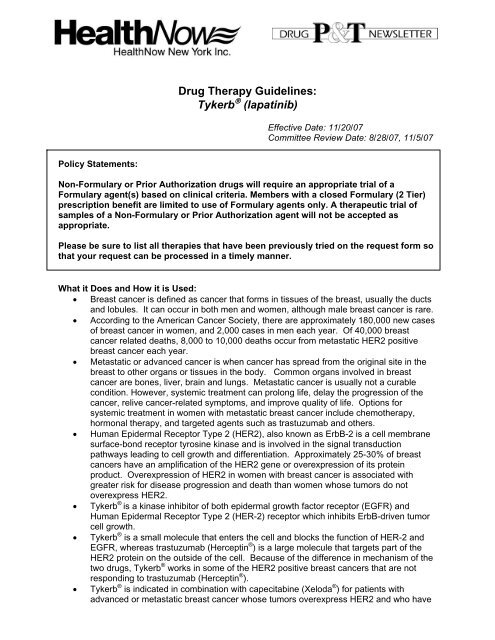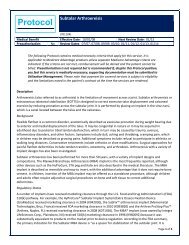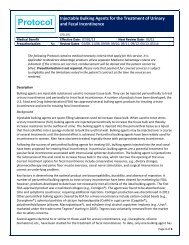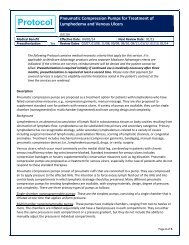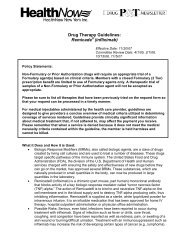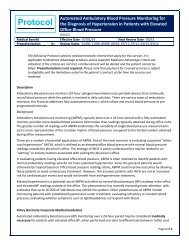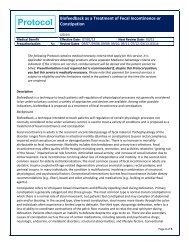Drug Therapy Guidelines: Tykerb (lapatinib)
Drug Therapy Guidelines: Tykerb (lapatinib)
Drug Therapy Guidelines: Tykerb (lapatinib)
Create successful ePaper yourself
Turn your PDF publications into a flip-book with our unique Google optimized e-Paper software.
<strong>Drug</strong> <strong>Therapy</strong> <strong>Guidelines</strong>:<strong>Tykerb</strong> ® (<strong>lapatinib</strong>)Effective Date: 11/20/07Committee Review Date: 8/28/07, 11/5/07Policy Statements:Non-Formulary or Prior Authorization drugs will require an appropriate trial of aFormulary agent(s) based on clinical criteria. Members with a closed Formulary (2 Tier)prescription benefit are limited to use of Formulary agents only. A therapeutic trial ofsamples of a Non-Formulary or Prior Authorization agent will not be accepted asappropriate.Please be sure to list all therapies that have been previously tried on the request form sothat your request can be processed in a timely manner.What it Does and How it is Used:• Breast cancer is defined as cancer that forms in tissues of the breast, usually the ductsand lobules. It can occur in both men and women, although male breast cancer is rare.• According to the American Cancer Society, there are approximately 180,000 new casesof breast cancer in women, and 2,000 cases in men each year. Of 40,000 breastcancer related deaths, 8,000 to 10,000 deaths occur from metastatic HER2 positivebreast cancer each year.• Metastatic or advanced cancer is when cancer has spread from the original site in thebreast to other organs or tissues in the body. Common organs involved in breastcancer are bones, liver, brain and lungs. Metastatic cancer is usually not a curablecondition. However, systemic treatment can prolong life, delay the progression of thecancer, relive cancer-related symptoms, and improve quality of life. Options forsystemic treatment in women with metastatic breast cancer include chemotherapy,hormonal therapy, and targeted agents such as trastuzumab and others.• Human Epidermal Receptor Type 2 (HER2), also known as ErbB-2 is a cell membranesurface-bond receptor tyrosine kinase and is involved in the signal transductionpathways leading to cell growth and differentiation. Approximately 25-30% of breastcancers have an amplification of the HER2 gene or overexpression of its proteinproduct. Overexpression of HER2 in women with breast cancer is associated withgreater risk for disease progression and death than women whose tumors do notoverexpress HER2.• <strong>Tykerb</strong> ® is a kinase inhibitor of both epidermal growth factor receptor (EGFR) andHuman Epidermal Receptor Type 2 (HER-2) receptor which inhibits ErbB-driven tumorcell growth.• <strong>Tykerb</strong> ® is a small molecule that enters the cell and blocks the function of HER-2 andEGFR, whereas trastuzumab (Herceptin ® ) is a large molecule that targets part of theHER2 protein on the outside of the cell. Because of the difference in mechanism of thetwo drugs, <strong>Tykerb</strong> ® works in some of the HER2 positive breast cancers that are notresponding to trastuzumab (Herceptin ® ).• <strong>Tykerb</strong> ® is indicated in combination with capecitabine (Xeloda ® ) for patients withadvanced or metastatic breast cancer whose tumors overexpress HER2 and who have
eceived prior therapy including an anthracycline, a taxane, and trastuzumab(Herceptin ® ).• An open-label study compared benefit of Lapatinib (<strong>Tykerb</strong> ® ) plus capecitabine(Xeloda ® ) vs. capecitabine (Xeloda ® ) alone in treating HER2-positive advanced breastcancer. Out of 163 and 161 patients enrolled in combination and monotherapy groupsrespectively, there were 49 disease-progression events in the combination armcompared to 72 in the monotherapy arm. The median time to disease progression(event or death) from start of the trial were 8.4 months with combination therapy and 4.4months with monotherapy. The overall survival rate did not differ between treatmentarms.• Recommended dosage of <strong>Tykerb</strong> ® is 1,250 mg (5 tablets) orally once daily on days 1-21continuously in combination with capecitabine (Xeloda ® ) 2,000 mg/m2/day on days 1-14in repeating 21 day cycle. <strong>Tykerb</strong> ® should be taken a least one hour before or one hourafter a meal. Xeloda ® should be taken with food or within 30 minutes after food.What it Costs:<strong>Tykerb</strong> ® - About $2,900 (AWP)Xeloda ® - About $2,160 (AWP)Rationale for Prior Authorization:To provide coverage for <strong>Tykerb</strong> ® in situations where the drug has shown effectiveness (i.e., ascombination therapy with capecitabine for advanced or metastatic HER2 positive breast cancerfor those of patient who have received prior therapy including an anthracycline, a taxane, andtranstuzumab).Benefit Design:Coverage is determined through a prior authorization process for every claim.Prior Authorization Criteria:Coverage for <strong>Tykerb</strong> ® is provided in accord with the following:• Coverage is provided for the treatment of patients with advanced or metastatic breastcancer whose tumors overexpress HER2 and who have experienced diseaseprogression following treatment that included an anthracycline, a taxane, andtrastuzumab (Herceptin ® ).• <strong>Tykerb</strong> ® must be used in combination with capecitabine (Xeloda ® ).Coverage Duration:Coverage is provided for 6 months. Coverage may be renewed in the absence of diseaseprogression. Coverage is provided for a quantity not to exceed five 250 mg tablets per day(1250 mg per day) and 150 tablets (37,500mg) per month unless the patient is receivingconcomitant therapy with a CYP 3A4 inducing drug (e.g., phenytoin, carbamazepine etc), inwhich case coverage is provided for doses up to 4500 mg per day.References:1. American Cancer Society. Breast Cancer Facts and Figures. Available from URL:http://www.cancer.org. Accessed March 2007.2. Geyer CE, Forster JM, Lindquist D, et al. Lapatinib plus Capecitabine for HER2-Positive Advanced Breast Cancer. N Eng J Med. 2006;335:2733-43.3. Lapatinib (<strong>Tykerb</strong> ® ). Prescribing information. GlaxoSmithKline. Research Triangle Park,NC: March 2007.4. National Cancer Institute: U.S. National Institutes of Health. Breast Cancer. Availablefrom URL: http://www.cancer.gov/cancertopics/wyntk/breast/page1. Accessed March2007.


